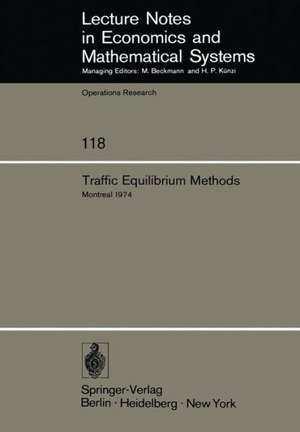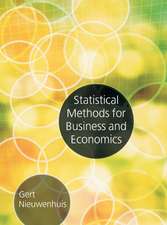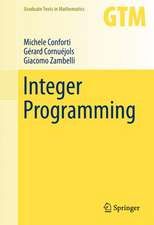Traffic Equilibrium Methods: Proceedings of the International Symposium Held at the Université de Montréal, November 21–23, 1974: Lecture Notes in Economics and Mathematical Systems, cartea 118
Editat de M.A. Florianen Limba Engleză Paperback – mar 1976
Din seria Lecture Notes in Economics and Mathematical Systems
-
 Preț: 360.02 lei
Preț: 360.02 lei -
 Preț: 383.93 lei
Preț: 383.93 lei - 15%
 Preț: 693.39 lei
Preț: 693.39 lei -
 Preț: 384.09 lei
Preț: 384.09 lei -
 Preț: 380.07 lei
Preț: 380.07 lei -
 Preț: 446.26 lei
Preț: 446.26 lei -
 Preț: 497.37 lei
Preț: 497.37 lei -
 Preț: 380.84 lei
Preț: 380.84 lei -
 Preț: 384.86 lei
Preț: 384.86 lei -
 Preț: 378.34 lei
Preț: 378.34 lei -
 Preț: 399.67 lei
Preț: 399.67 lei - 20%
 Preț: 360.93 lei
Preț: 360.93 lei - 15%
 Preț: 643.16 lei
Preț: 643.16 lei -
 Preț: 379.09 lei
Preț: 379.09 lei -
 Preț: 404.76 lei
Preț: 404.76 lei -
 Preț: 385.62 lei
Preț: 385.62 lei - 15%
 Preț: 644.49 lei
Preț: 644.49 lei -
 Preț: 379.09 lei
Preț: 379.09 lei -
 Preț: 345.50 lei
Preț: 345.50 lei -
 Preț: 425.80 lei
Preț: 425.80 lei -
 Preț: 378.34 lei
Preț: 378.34 lei - 18%
 Preț: 775.65 lei
Preț: 775.65 lei -
 Preț: 392.60 lei
Preț: 392.60 lei - 15%
 Preț: 646.43 lei
Preț: 646.43 lei -
 Preț: 382.18 lei
Preț: 382.18 lei -
 Preț: 378.34 lei
Preț: 378.34 lei - 15%
 Preț: 637.59 lei
Preț: 637.59 lei - 15%
 Preț: 647.27 lei
Preț: 647.27 lei -
 Preț: 377.73 lei
Preț: 377.73 lei -
 Preț: 447.84 lei
Preț: 447.84 lei - 15%
 Preț: 644.49 lei
Preț: 644.49 lei -
 Preț: 386.00 lei
Preț: 386.00 lei - 15%
 Preț: 654.43 lei
Preț: 654.43 lei -
 Preț: 415.02 lei
Preț: 415.02 lei -
 Preț: 411.54 lei
Preț: 411.54 lei -
 Preț: 398.92 lei
Preț: 398.92 lei -
 Preț: 398.92 lei
Preț: 398.92 lei -
 Preț: 392.75 lei
Preț: 392.75 lei - 15%
 Preț: 635.47 lei
Preț: 635.47 lei - 20%
 Preț: 653.56 lei
Preț: 653.56 lei -
 Preț: 379.86 lei
Preț: 379.86 lei -
 Preț: 495.46 lei
Preț: 495.46 lei -
 Preț: 447.99 lei
Preț: 447.99 lei -
 Preț: 378.71 lei
Preț: 378.71 lei - 15%
 Preț: 637.13 lei
Preț: 637.13 lei -
 Preț: 385.84 lei
Preț: 385.84 lei -
 Preț: 378.54 lei
Preț: 378.54 lei - 15%
 Preț: 666.55 lei
Preț: 666.55 lei
Preț: 401.61 lei
Nou
Puncte Express: 602
Preț estimativ în valută:
76.85€ • 82.18$ • 64.07£
76.85€ • 82.18$ • 64.07£
Carte tipărită la comandă
Livrare economică 18 aprilie-02 mai
Preluare comenzi: 021 569.72.76
Specificații
ISBN-13: 9783540076209
ISBN-10: 3540076204
Pagini: 464
Ilustrații: XXIV, 435 p. 9 illus.
Dimensiuni: 170 x 244 x 24 mm
Greutate: 0.74 kg
Ediția:Softcover reprint of the original 1st ed. 1976
Editura: Springer Berlin, Heidelberg
Colecția Springer
Seria Lecture Notes in Economics and Mathematical Systems
Locul publicării:Berlin, Heidelberg, Germany
ISBN-10: 3540076204
Pagini: 464
Ilustrații: XXIV, 435 p. 9 illus.
Dimensiuni: 170 x 244 x 24 mm
Greutate: 0.74 kg
Ediția:Softcover reprint of the original 1st ed. 1976
Editura: Springer Berlin, Heidelberg
Colecția Springer
Seria Lecture Notes in Economics and Mathematical Systems
Locul publicării:Berlin, Heidelberg, Germany
Public țintă
ResearchCuprins
i. General Modelling Considerations.- “Traffic Equilibrium Methods: The Structure of Model Research”.- “Equilibrium Models in Use: Practical Problems and Proposals for Transport Planning”.- ii. Theoretical Studies.- “Highway- Traffic Equilibria Analysed Via Geometric Programming”.- “Integrated Equilibrium Flow Models for Transportation Planning”.- “Equilibrium Versus Optimum in Public Transportation Systems”.- “Statistical Equilibrium”.- “Transportation Model with Elastic Constraints”.- iii. Computational Methods.- “A Unified Approach to Equilibrium Methods for Traffic Assignment”.- “Network Equilibrium Capabilities for the UMTA Transportation Planning System”.- “Application of Error Measures to Traffic Assignment Results”.- “Some Models for Combining the Trip Distribution and Traffic Assignment Stages in the Transport Planning Process”.- “Multiple Route Assignment: A Comparison of Two Methods”.- iv. Dynamic Traffic Assignment Methods.- “Emulation of Dynamic Equilibrium in Traffic Networks.- “A Model and an Algorithm for the Dynamic Traffic Assignment Problem”.- v. Traffic Equilibrium and Traffic Control.- “Area Traffic Control and Network Equilibrium”.- “Evaluation of Freeway Corridor Assignment Equilibria”.- vi. Model Components.- “Supply Functions for Public Transport: Initial Concepts and Models”.- “A Note on the Economic Interpretation of Delay Functions in Assignment Problems”.- vii. Applications Of Traffic Equilibrium Methods.- “Recent Experience with Equilibrium Methods for the Study of a Congested Urban Area”.- “The Choice of Assignment Techniques for Large Networks”.- “An Analysis and Comparison of Behavioral Assumptions in Traffic Assignment”.- “An Investigation of SomeProblems in the Calibration of Traffic Assignments”.- “The Use of Traffic Equilibrium Based Problem-Oriented Language for a Governmental Feasibility Study”.










